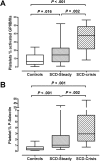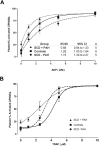Platelet activation in patients with sickle disease, hemolysis-associated pulmonary hypertension, and nitric oxide scavenging by cell-free hemoglobin
- PMID: 17536019
- PMCID: PMC1976348
- DOI: 10.1182/blood-2006-12-061697
Platelet activation in patients with sickle disease, hemolysis-associated pulmonary hypertension, and nitric oxide scavenging by cell-free hemoglobin
Abstract
Increased platelet activation is recognized in patients with sickle cell disease (SCD), but its pathogenesis and clinical relevance remain uncertain. Pulmonary arterial hypertension (PAH), an important complication of SCD, is characterized by a proliferative pulmonary vasculopathy, in situ thrombosis, and vascular dysfunction related to scavenging of nitric oxide (NO) by hemoglobin released into blood plasma during intravascular hemolysis. We investigated links between platelet activation, PAH and NO scavenging in patients with SCD. Platelet activation marked by activated fibrinogen receptor correlated to the severity of PAH (r = 0.58, P < .001) and to laboratory markers of intravascular hemolysis, such as reticulocyte count (r = 0.44, P = .02). In vitro exposure of platelets to pathologically relevant concentrations of cell-free hemoglobin promoted basal- and agonist-stimulated activation and blocked the inhibitory effects on platelet activation by an NO donor. In patients with SCD, administration of sildenafil, a phosphodiesterase-5 inhibitor that potentiates NO-dependent signaling, reduced platelet activation (P = .01). These findings suggest a possible interaction between hemolysis, decreased NO bioavailability, and pathologic platelet activation that might contribute to thrombosis and pulmonary hypertension in SCD, and potentially other disorders of intravascular hemolysis. This supports a role for NO-based therapeutics for SCD vasculopathy. This trial was registered at www.clinicaltrials.gov as no. NCT00352430.
Figures




References
-
- Setty BN, Rao AK, Stuart MJ. Thrombophilia in sickle cell disease: the red cell connection. Blood. 2001;98:3228–3233. - PubMed
-
- Brown MD, Wick TM, Eckman JR. Activation of vascular endothelial cell adhesion molecule expression by sickle blood cells. Pediatr Pathol Mol Med. 2001;20:47–72. - PubMed
-
- Francis RB., Jr Protein S deficiency in sickle cell anemia. J Lab Clin Med. 1988;111:571–576. - PubMed
-
- Lard LR, Mul FP, de Haas M, Roos D, Duits AJ. Neutrophil activation in sickle cell disease. J Leukoc Biol. 1999;66:411–415. - PubMed
Publication types
MeSH terms
Substances
Associated data
Grants and funding
LinkOut - more resources
Full Text Sources
Other Literature Sources
Medical

